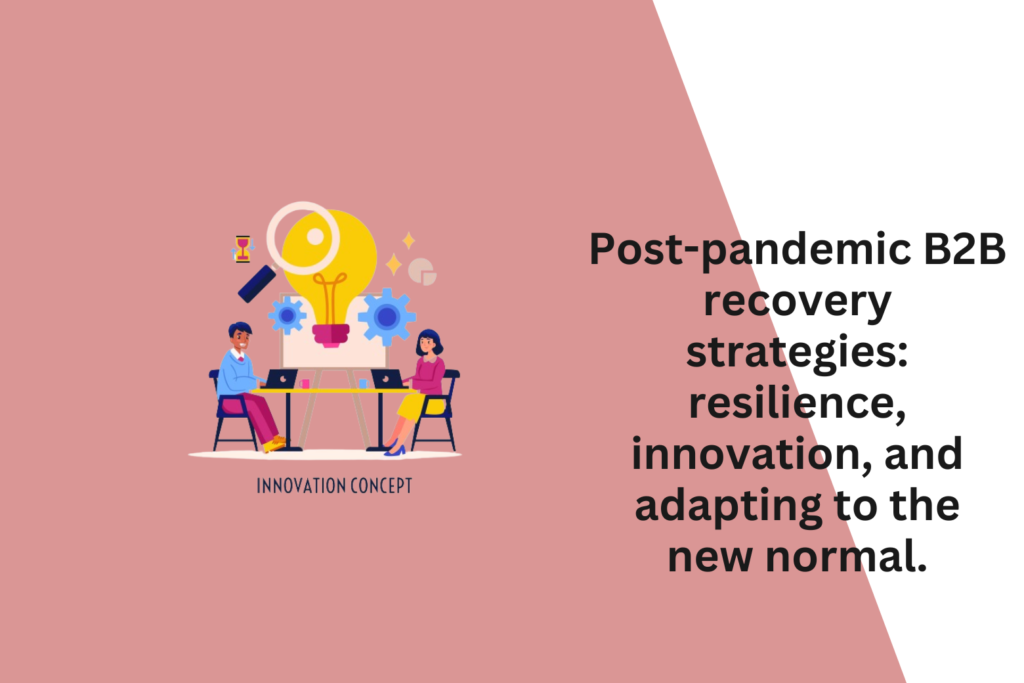
Navigating the post-pandemic landscape requires B2B businesses to adopt recovery strategies that emphasize resilience, innovation, and adaptability to the new normal. The disruptions caused by the pandemic have reshaped the business landscape, and successful recovery hinges on strategic responses. Here’s a closer look at key strategies for B2B recovery:
1. Build Resilience:
- Diversify Supply Chains: The pandemic exposed vulnerabilities in global supply chains. Consider diversifying suppliers and adopting a more resilient and flexible supply chain strategy to mitigate risks associated with disruptions.
- Risk Assessment and Contingency Planning: Regularly assess potential risks and develop contingency plans. This includes financial planning, supply chain disruptions, and other contingencies that could impact business operations.
2. Embrace Innovation:
- Digital Transformation: Accelerate digital transformation efforts to enhance operational efficiency and improve customer experiences. Leverage technologies such as AI, automation, and data analytics to streamline processes and gain a competitive edge.
- New Product or Service Offerings: Innovate by introducing new products or services that cater to evolving market needs. Understand the changing demands of your customers and adapt your offerings accordingly.
3. Adapt to the New Normal:
- Remote Work Integration: If applicable, embrace and optimize remote work capabilities. Provide the necessary tools and technologies to ensure productivity, collaboration, and employee well-being in a hybrid or remote work environment.
- E-commerce and Online Presence: Strengthen your online presence and e-commerce capabilities. The shift to digital interactions is likely to persist, so having a robust online presence is essential for customer engagement and sales.
4. Enhance Customer Engagement:
- Customer-Centric Approach: Prioritize customer needs and expectations. Listen to customer feedback, adapt your offerings based on their evolving requirements, and provide excellent customer service to build and maintain strong relationships.
- Personalized Communication: Tailor your communication strategies to be more personalized and empathetic. Address the challenges your clients are facing and position your products or services as solutions that can help them navigate the changing landscape.
5. Strategic Partnerships:
- Collaborate with Industry Partners: Explore strategic partnerships with other businesses in your industry. Pooling resources and expertise can create synergies and foster collective recovery.
- Supply Chain Collaboration: Foster collaboration within your supply chain. Open communication and collaborative problem-solving can help ensure the resilience of the entire ecosystem.
6. Employee Well-being:
- Focus on Employee Well-being: Prioritize the well-being of your workforce. Implement policies and practices that support mental health, work-life balance, and overall employee satisfaction.
- Continuous Learning and Development: Invest in continuous learning and development programs for your employees. Equip them with the skills needed to thrive in the evolving business landscape.
7. Agile Decision-Making:
- Agile Business Practices: Adopt agile decision-making processes to respond swiftly to market changes. Develop a culture that encourages adaptability and quick responses to emerging opportunities or challenges.
8. Financial Stewardship:
- Financial Planning and Efficiency: Conduct thorough financial planning to ensure stability. Explore cost-saving measures and operational efficiencies without compromising on quality or customer experience.
- Explore Financial Assistance Programs: Stay informed about government or industry-specific financial assistance programs that can provide support during challenging times.
9. Sustainability Initiatives:
- Environmental and Social Responsibility: Embrace sustainability initiatives that align with environmental and social responsibility. Consumers and businesses increasingly value sustainability, and integrating such practices can enhance your brand image.
In summary, post-pandemic recovery for B2B businesses involves a multifaceted approach that combines resilience, innovation, and adaptability. By focusing on these strategies, businesses can not only recover from the challenges posed by the pandemic but also position themselves for sustained growth in the evolving business landscape.



